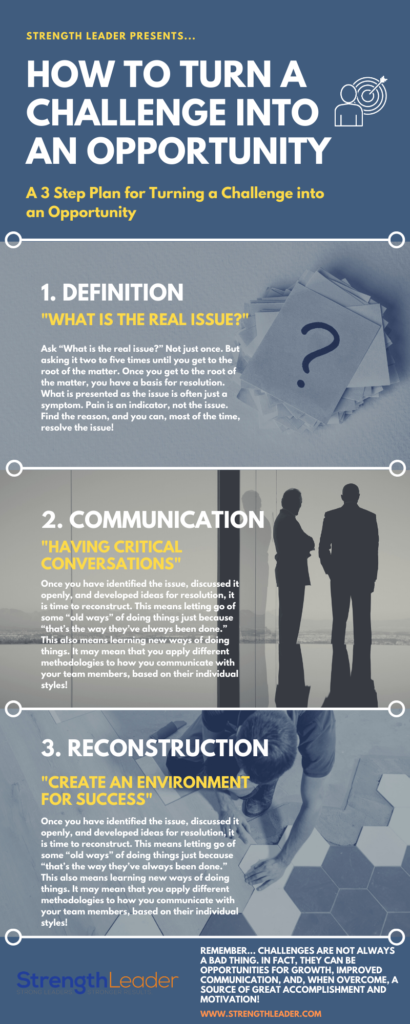
Image Credit: Shutterstock
When it comes to leadership, it is not a matter of IF there will be challenges; it is a simple a matter of WHEN they will come…because they will, most definitely, come.
But challenges are not always a bad thing. In fact, they can be opportunities for growth, improved communication, and, when overcome, a source of great accomplishment and motivation.
It is hard to see these end results when you are facing such challenges. This is where experienced leadership comes into play. When you have a track record of overcoming challenges, you begin to recognize them for what they are and develop processes for effectively working through them.
For new leaders, it helps to “learn the ropes” from experienced leaders.
Here is a simple three-part plan for turning challenge into opportunity.
1. Definition
You do this by asking, “What is the real issue?” Not just once. But asking it two to five times until you get to the root of the matter. Once you get to the root of the matter, you have a basis for resolution.
It is a bit like going to the doctor.
“My leg hurts.”
One doctor may give you a pain pill and send you on your way. This addresses the symptom, but the underlying problem remains and could become more acute.
But the doctor you really want is the one will ask questions and do some testing to get to the root cause…because only then will you have a more permanent resolution to the problem.
Communication is similar. What is presented as the issue is often just a symptom. Pain is an indicator, not the issue. Find the reason, and you can, most of the time, resolve the issue.
“I hate my job.”
“What about your job causes this pain?”
“My boss.”
“What does your boss do that causes you to hate your job?”
This line of questioning helps to identify the true cause of disengagement and provides a pathway for resolution.
And that pathway is…
2. Communication
Once a problem is clearly identified, you must confront it together. This means having critical conversations where each person can freely voice their thoughts, ideas, and feelings, and be heard. Communication is a two-way street. By hearing and speaking, you share ideas and solutions. It can be an amazing opportunity for growth.
The goal of communication should be…
3. Reconstruction
Once you have identified the issue, discussed it openly, and developed ideas for resolution, it is time to reconstruct. This means letting go of some “old ways” of doing things just because “that’s the way they’ve always been done.”
This also means learning new ways of doing things. It may mean that you apply different methodologies to how you communicate with your team members, based on their individual styles.
It may mean developing new systems and processes that fit the team’s working style.
It may mean creating an environment that sets your team up for success and keeps them motivated.
In any reconstruction project, the process starts with tearing out the old, down to a solid foundation, and then building on that.
Are you facing challenges in your business? Follow this plan.
- Define the issue.
- Communicate openly with your team and anyone involved.
- Reconstruct based on what you have learned.
It is only when you confront the challenge for what it is, and enlist support, that you can begin to overcome it.
—
For more resources on how you can you can learn the strengths of your team and get amazing results, click here to learn about the Maxwell Method of Communication Impact Report.

As the CEO of Strength Leader Development, Deb Ingino is a highly sought-after international executive mentor, coach, trainer and speaker. Deb is well versed in global business operations and helps business leaders and their teams to discover and leverage their strengths, so they can create highly collaborative teams that deliver great results. With a refreshingly direct style, Deb helps leaders and their teams to deliver profitable results. Connect with Deb to learn more about her mentorship and coaching programs to equip you with advanced strategies to elevate your results.
+ view comments . . .